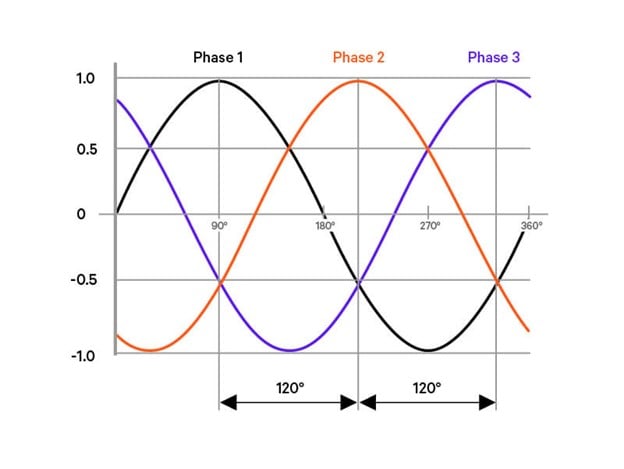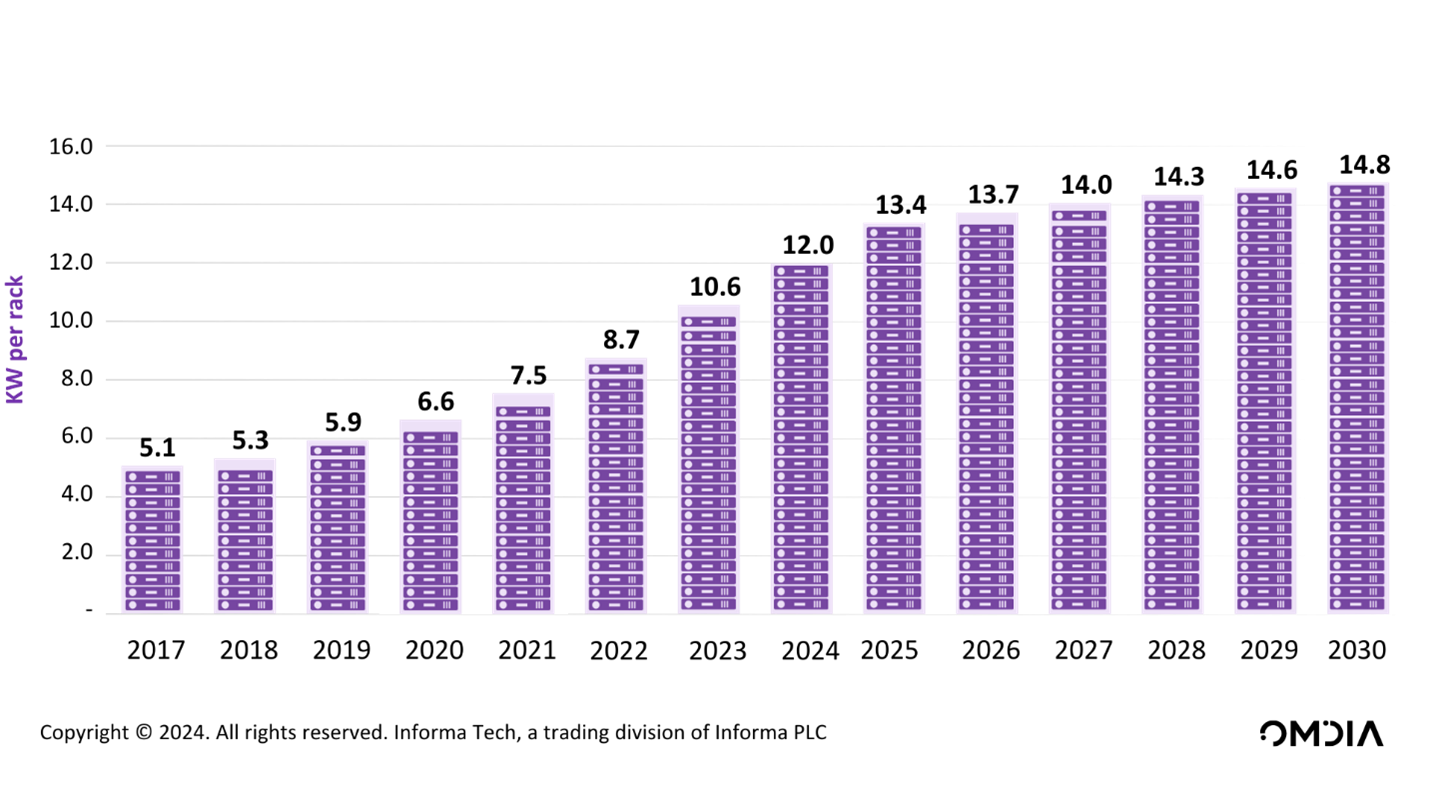Over recent years, the average rack density has steadily risen, with hyperscale providers running at higher densities. This surge underscores the crucial need for high-density rack PDUs to manage power distribution effectively.
Moreover, server racks that train large AI models require even higher power, with some configurations reaching up to 50 kW per rack. As data centers evolve, configurations with densities of up to 100 kW are becoming increasingly common, emphasizing the need for higher-density rack PDUs to efficiently manage power distribution and thermal management within these environments.
| Provider | Server Nodes per Rack | Power Consumption per Rack |
|---|---|---|
| Meta | Up to 128 | 12.5 - 15.8 kW |
| Microsoft | 72 to 92 | Up to 24.5 kW |
| Amazon | Average of 28 | Around 17 kW |
The significance of Three-Phase Power in AI and HPC
As data centers and server rooms become more densely packed with robust computing systems, the efficiency of power delivery systems becomes critical. Three-phase power systems stand out for their capacity to efficiently meet the high-power demands of AI and High-Performance Computing (HPC) workloads.
Efficiency gains with Three-Phase Power
Traditionally, IT racks could run on a fraction of the power needed today. What used to be a 5 kW demand per rack has surged to 20-30 kW due to the denser packing of servers. This increase underscores the importance of efficiency; three-phase power systems are designed to support these power-hungry environments effectively.
Wiring considerations and power distribution
Three-phase power not only supports higher capacities but also uses more manageable wiring. For the same 15 kW rack, Three-Phase Power uses smaller, more easily managed wires, reducing installation costs and complexity. This efficiency in power distribution is crucial for maintaining smooth operations in high-density computing environments.

Explaining Three-Phase Power: When phase 1 reaches its positive peak, phases 2 and 3 are simultaneously at -0.5. This configuration ensures that, unlike in single-phase current systems, there is never a moment when power delivery to the load ceases. In fact, across six distinct points in each phase cycle, one of the lines will be at its maximum positive or negative value.
How Three-Phase Power works
Three-phase power connects three voltage sources or loads, optimizing distribution. The two most common three-phase power systems are the 208V Delta and the 240-415V WYE, designed to meet the demands of high-density computing with greater efficiency.
| 208V Delta | VS | 240/415V WYE | |
|---|---|---|---|
| Voltage | Provides voltage levels ranging from 200-240V, with the most common being 208V. | Provides voltage range of 200-240/346-415V, with the most common being 240V (NAM) or 230V (EMEA) Line-to-Neutral output. | |
| Configuration | Employs a triangular connection of three phases (AB, BC, and CA) without a neutral wire. | Three phases joined in a Y-shaped pattern and connected by a neutral wire. | |
| Applications | Legacy servers, blade servers and micro servers. | High-performance servers, storage arrays, and networking equipment. | |
| Advantages | Power Efficiency: Well-suited for high-power applications due to its voltage range. Compatibility with Legacy Equipment: In retrofit scenarios, where older equipment is still in use, the 208V Delta system provides Cost-Effectiveness: Existing installations can use it without major infrastructure changes. |
Global Availability: WYE power systems operating at 240/415V are more commonly used than 208V Delta systems. This widespread adoption standardizes components and simplifies maintenance and replacements, streamlining installation and upkeep. Scalable Power: Accommodates increased demands as a data center expands or adds new equipment. |
Three-Phase rack PDU at a glance
Maximizing AI and HPC performance with switched rack PDUs
Switched rPDUs are at the heart of intelligent power management, offering unparalleled benefits for AI and HPC applications. They deliver essential capabilities that enhance the performance and reliability of these demanding environments:
Remote management
Switched rPDUs allow for the remote control of power to individual outlets through an intuitive web interface. This enables remote power on, off, or reboot actions for equipment, eliminating thprops="{"335559738":240,"335559739":240}">
Preventing overloads
By enabling power usage limits at each outlet, switched rPDUs prevent accidental overloads, which is crucial for the stable and reliable power supply to sensitive computing equipment.
Operational efficiency
The capability for remote rebooting through switched rPDUs drastically lowers or even eliminates technicians' need for manual power cycling, boosting operational efficiency and ensuring higher system uptime.
Energy efficiency
Vertiv™ PowerIT GU2 rPDUs feature bi-stable outlet relays that magnetically latch. These relays maintain their state without continuous power, enhancing efficiency and cutting energy costs. These relays automatically open when the rPDU is turned off or loses power, ensuring that user-selected outlet sequencing activates upon power restoration.
Rack PDU Services
The following sections detail how our comprehensive rPDU assurance services support AI and HPC workload performance, offering everything from expert installation to around-the-clock support and emergency response.
Startup and Installation
Factory-authorized Vertiv™ technicians ensure hassle-free rPDU installation and startup, freeing IT staff for other tasks.
Seven-Year Protection Plan
With seven years of 100% coverage for labor, travel, and parts, the Distribution Assurance Package cuts unexpected downtime costs and enhances network availability.
Removal & Disposal
As part of the Distribution Assurance Package, our technicians can also remove and dispose of old rPDUs in compliance with regulations.
On-site Support & Emergency Response
Vertiv offers top-tier support for all rPDU types with 24x7 access to our Customer Resolution Center for swift problem resolution and prompt emergency response.
Comprehensive Reports
Gain instant access to service histories and reports through the Customer Services Network portal, simplifying management and oversight of your rPDUs.
Your strategic partner in advanced power management
Vertiv™ PowerIT rPDUs are designed to meet the high demands of AI and HPC environments, providing the visibility, efficiency, and reliability needed to support complex workloads. Explore our rPDU web demos and discover how our power distribution solutions can advance your data center's power management strategy.



